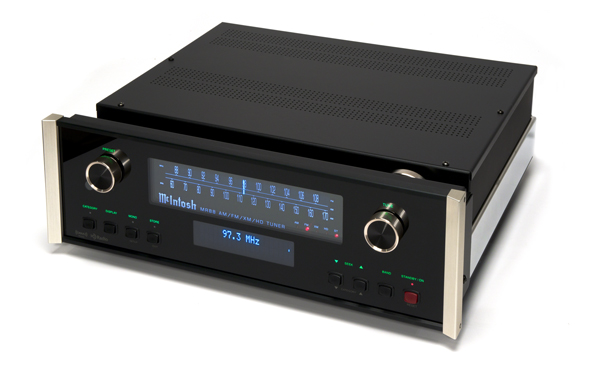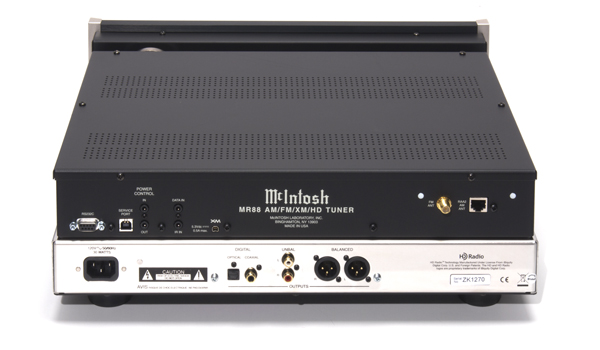McIntosh MR88 Covers every format
By Rich Colburn Sometimes, one longs for the hi-fi simplicity of the 1970s. Back then, FM radio functioned as the prime source of listening for many a music lover. AOR FM was in high gear, and people just tuned into any number of stations to get a music fix. Those with audiophile leanings often invested in a separate tuner to optimize the FM sound quality. Often, a manufacturer’s top-of-the-line tuner represented the best and most highly engineered product in its whole line. Companies such as Yamaha, Pioneer, SAE, Kenwood, Sansui, Marantz, Technics, Sony, and McIntosh waged a high-stakes tech war to see who could develop the king of the airwaves: A tuner with clean, clear reception coupled with good sound.
Sometimes, one longs for the hi-fi simplicity of the 1970s. Back then, FM radio functioned as the prime source of listening for many a music lover. AOR FM was in high gear, and people just tuned into any number of stations to get a music fix. Those with audiophile leanings often invested in a separate tuner to optimize the FM sound quality. Often, a manufacturer’s top-of-the-line tuner represented the best and most highly engineered product in its whole line. Companies such as Yamaha, Pioneer, SAE, Kenwood, Sansui, Marantz, Technics, Sony, and McIntosh waged a high-stakes tech war to see who could develop the king of the airwaves: A tuner with clean, clear reception coupled with good sound.
MR65B, MR71, MR74, MR78…MR88?
At first glance, I mistook the MR88 for a classic McIntosh model, with the stellar MR65B and MR74 coming to mind. The $4,000 unit’s cosmetics are distinctly retro. A tuning knob connected to a flywheel, a glass tuning dial, and an illuminated dial pointer reinforce the traditional McIntosh appearance. But any analog suggestions are instantly dispelled upon power up: A window displays station frequency, shows station call letters, and scrolls RBDS text when the unit is switched on.
The MR88 is basically an all-digital DSP device that uses every manner of technological wizardry to deliver terrestrial or satellite signals in crystal clear, noise-free fashion. It even has an spdif digital out that can be sent to your favorite DAC, via a coax or Toslink cable. Various other provisions make the MR88 a thoroughly modern, future-proof component. An RS232 port is at the ready for communicating with an external control device; a service port allows for firmware upgrades; an IR input, power control input, and output for receiving and sending trigger signals to and from other McIntosh components round out the prudent touches.
Master of the Frequency Domains
Once installed and warmed up, the MR88 was put through its paces as an analog-only tuner. A default receiving mode will automatically select the HD feed from many stations, but setting it to receive the non-HD signal is easy. I connected the unit to my preamp using the greatly appreciated balanced outputs; an outdoor antenna was connected via an F-connector located on the back of the tuner.
While my standby Kenwood KT-8005 grabs about 15 stations with a strong low-noise and low-distortion signal, the MR88 claimed 18. A local jazz station, KMHD, came in strong and clear, as did KQAC, the local classical station. Both provided many hours of pleasurable listening through the MR88. Its ability to throw a convincingly deep and wide soundstage fooled more than a few listeners into thinking a CD was playing. However, the tuner’s greatest strength lies elsewhere.
Switching to back the default Auto receiving mode, the listener will hear a blending of the analog and digital signals that provides the best sound quality. Stations with HD broadcasting capability come in with noise-free clarity. The user also gets a much wider bandwidth with HD. Compared to the analog signals, bass extension goes lower and high frequencies extend further. iBiquity Digital Corp., the purveyor of HD technology, touts the sound as CD quality. A slight exaggeration, as the signal is basically an audio compression codec combined with an enhancer called SBR (spectral band replication). The latter replicates higher frequency content by transposing harmonics up from the lower and mid-frequencies at the decoder. Theoretically, SBR is based on the principle that the psychoacoustic part of the human brain tends to analyze higher frequencies with less accuracy, thus any harmonic phenomena associated with the spectral band replication process needs only be accurate in a perceptual sense, and not technically or mathematically exact.
Such myriad handling of the signal yields a slightly artificial aspect to the sound that owes to the nature of the format, not the MR88. Purist audiophiles might not fully endorse the sound, but average listeners should be quite pleased, especially considering the added content currently available on HD. As you move up and down the dial with the handy remote, you can hear the tuner first grab the analog signal and then switch over to the HD broadcast. Once the transfer occurs, one instantly perceives the increase in clarity and bandwidth. Moreover, there’s a dramatic reduction of noise on marginal signals. Employing this mode, the number of listenable stations in my area rose to 35 due to the HD2 and HD3 broadcasts. 
AM, XM: The MR88 Does It All
Fans of Howard Stern and Major League Baseball broadcasts, rejoice. The MR88 is also XM Satellite Radio enabled, further increasing the content options and variety. As with AM and FM, the MR88 allows users to program up to 20 preset XM channels.
Want more? The MR88 also does wonders with the AM band. News, weather, talk, and sports are here for the taking. And AM reception quality is no afterthought. An innovative AM antenna deemed the RAA2 connects to the tuner via 20 feet of network cable, enabling optimum antenna positioning and mounting. Aficionados will recognize the approach as a far cry from foldout ferrite rods, ubiquitous on the back panels of most old-school tuners.
Speaking of the old school, adding more digital to the mix often yielded poorer sonics. While I experimented by using the digital out to my DAC, and comparing the sound quality with the balanced analog out signal, results were mixed. The most satisfying overall sound was obtained through the analog output stage.
Can streaming audio on the Internet replicate what the MR88 accomplishes? Some might be tempted to think so. But the MR88 is a different animal. From the comfort of a sofa, you can enjoy favorite FM broadcasts, listen to HD Radio content, dive into XM Radio, and get the weather report without moving so much as the remote control.
Indeed, the MR88 is a substantial audio component that’s steeped in McIntosh tradition. Sturdily built with a giant power supply, great fit and finish, wonderful looks, and excellent performance, it offers a thoroughly modern and forward-looking take on the traditional AM/FM tuner.
MSRP: $4,000
McIntosh Laboratory, Inc.
2 Chambers St.
Binghamton, NY 13903-2699
(800) 538-6576
mcintoshlabs.com



